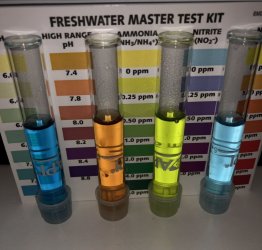I recently started up a tank. I used to keep bettas with my grandma (mostly just helped her feed them lol) and didn’t realize what care went into fish keeping. That being said, I had an impulse moment and bought a betta. I had him in a ten gallon alone but wanted to start a community because he didn’t seem aggressive. Since the only thing I ever kept were single bettas at a time, I didn’t know I couldn’t add multiple fish at once, should let the tank cycle before adding fish and so on. The store employee also didn’t let me know so I found this out after I had added more to the tank a week after the betta. I got a testing kit and the ammonia has been high so I’ve been doing daily water changes. It seems like the ammonia just won’t go down. The fish don’t seem in distress, but I am still worried.
I have 2 guppies
3 small albino Cory catfish
1 male betta
These are the readings I’m getting based on api master test kit:
PH 7.6
Hard PH 7.4
Ammonia .25
Nitrate between 0-5.0
Nitrite 0
I have tried adding the AmGuard ammonia neutrilazer in hopes to get it to 0 along with water changes but I’m having no luck. What else can I do? I have the Fluval Nano filter with 2 sponges and some bio rings and a small air stone set on a lower low. Also many live Anubias variations.
I have 2 guppies
3 small albino Cory catfish
1 male betta
These are the readings I’m getting based on api master test kit:
PH 7.6
Hard PH 7.4
Ammonia .25
Nitrate between 0-5.0
Nitrite 0
I have tried adding the AmGuard ammonia neutrilazer in hopes to get it to 0 along with water changes but I’m having no luck. What else can I do? I have the Fluval Nano filter with 2 sponges and some bio rings and a small air stone set on a lower low. Also many live Anubias variations.


